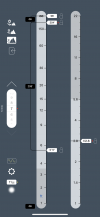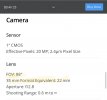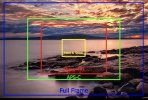It has to do with depth of field, hyperfocal distance and the optics of the lens. This works for anything and everything on that camera because it’s a fixed lens with a fixed aperture. Photographs, video, night, day, etc. It is the physical characteristic of the lens itself and doesn’t change.
And just to be clear none of this is my opinion and this isn’t some controversial fringe theory. This is science based fact that every professional photographer will understand. This concept works for all cameras but the values will be different depending on the lens. We’ll focus just on the
Air 2s lens.
The depth of field describes how much of the photo or video will be in sharp focus. When you tap to focus on something that sets your focus distance. If you tap to focus on something 30 feet away that means your focus distance is 30 feet.
Now it’s not just things that are exactly 30 feet away that will be in focus when you do that. Depending on some other factors things that are a certain distance in front of and back of your 30 foot focus distance will also be in focus. Your focus distance, lens focal length, aperture, and sensor size will determine how much is in focus. There is a formula for this but so have a handy dandy calculator on my phone to compute it.
The focal length of the lens is 7mm and this is fixed it never changes.
The aperture of this lens is 2.8 and this is fixed it never changes.
We know the sensor size is 1” type which isn’t actually 1 inch of anything contrary to popular belief and from here we can determine the circle of confusion is 11 nanometers. You’ll just have to take my word on this. There could be an entire conversation dedicated to what this means and how I got there but for now you don’t need to know what it means as long as we know what value we need to put it into the calculator
So I put those know and constant values into the calculator and then find the focus distance value that would give you the most depth of field
View attachment 131411
If you focus the camera to 30’ 1” everything that is 4’ 8” away from you all the way to infinity will be in focus. That is enough so that we can say everything will be in focus if you set you focus distance (tap to focus on something about 30 feet away). Even if you focus at 20 feet or 50 feet you get about the same values so like I said it doesn’t have to be exactly 30 feet that just seems like a good sweet spot. This is called the hyperfocal distance, the focus distance that gives you the most depth of field. Some people call this infinity focus even though that’s technically not the correct name for it. Using this how drones like the
Mini 2 doesn’t even have adjustable focus. It’s just has the lens mechanically locked at the hyperfocal distance.
I know there’s a lot there to unpack but if you look up videos on depth of field and hyperfocal distance you can learn more. Basically it comes down to the
Air 2s having a really wide 7mm lens and a small sensor (compared to 35mm cameras) that make it able to do this.















